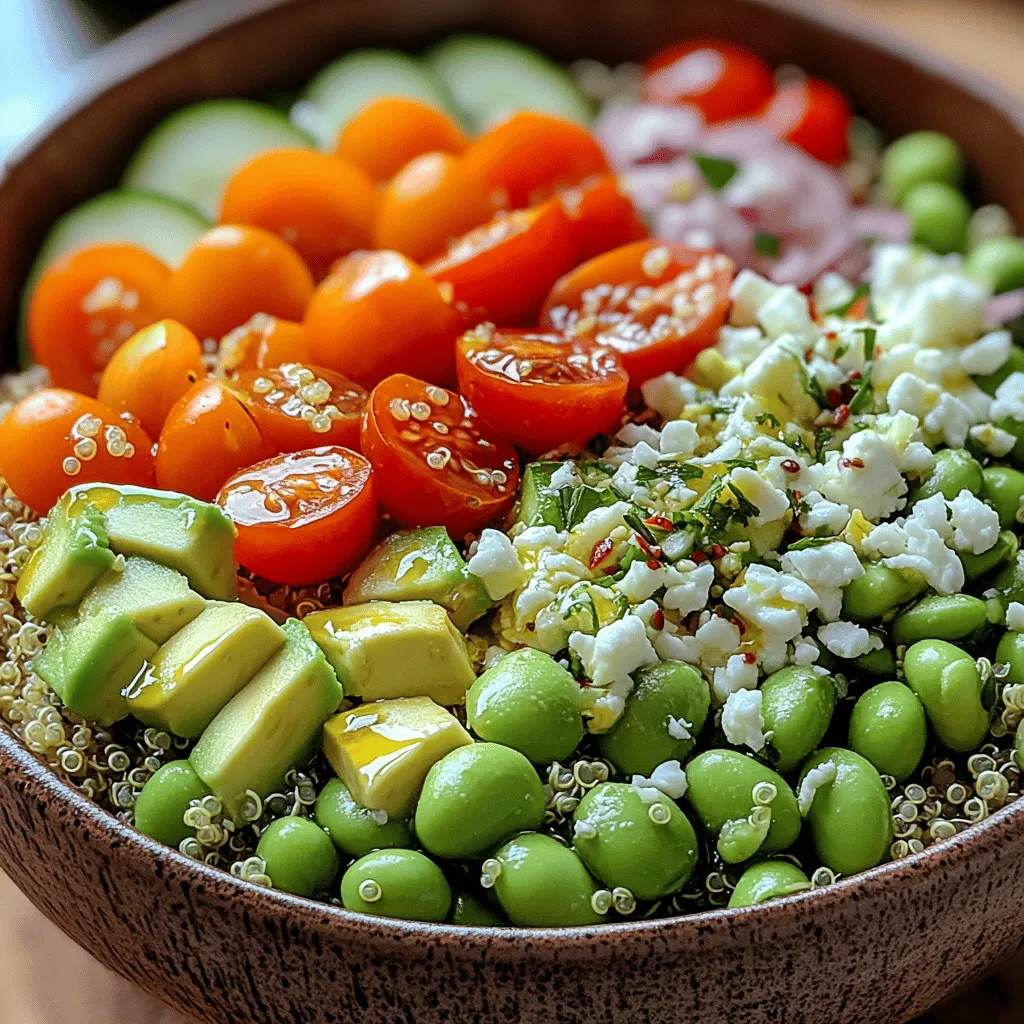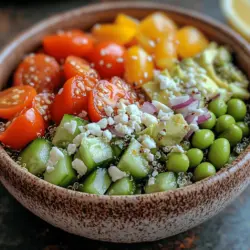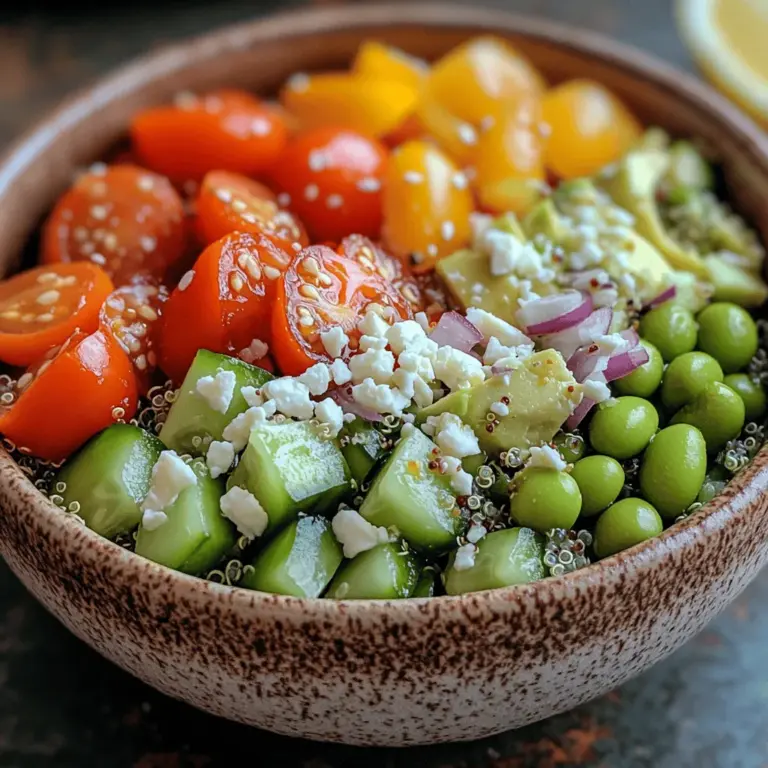In the ever-evolving world of healthy eating, the Refreshing Cold Quinoa Edamame Bowl stands out as a vibrant, nutrient-dense option that perfectly balances flavor and nourishment. This dish not only offers a delightful medley of textures and tastes but also boasts a wealth of protein, fiber, and essential vitamins. Quinoa, with its nutty flavor and light fluffiness, serves as the perfect base, complemented by the tender edamame and an array of fresh vegetables. Whether you are looking for a satisfying meal prep option or a light lunch to enjoy on a hot day, this recipe is simple to prepare and can be customized to suit your palate.
The origins of quinoa date back thousands of years to the Andean region of South America, where it was a staple food for the Incas. Revered as a “superfood,” quinoa has gained popularity in modern health cuisine due to its impressive nutritional profile. Edamame, young soybeans harvested before they ripen, are equally celebrated for their protein content and versatility in dishes. Together, these ingredients create a nutritious powerhouse that many health enthusiasts are eager to incorporate into their diets.
In this article, we’ll delve into the ingredients that make the Refreshing Cold Quinoa Edamame Bowl a go-to healthy meal, provide a step-by-step guide on how to prepare it, and explore the nutritional benefits and variations to suit your taste preferences.
Understanding the Ingredients
Quinoa: A Superfood Staple
Quinoa is often hailed as a superfood, and for good reason. This gluten-free grain is packed with essential nutrients that make it a staple in many health-conscious kitchens. A single cup of cooked quinoa contains approximately 8 grams of protein, making it one of the few plant-based foods that provide a complete protein source, meaning it contains all nine essential amino acids. Additionally, quinoa is high in fiber, which aids in digestion and helps maintain a healthy gut.
Beyond protein, quinoa is rich in vitamins and minerals, including magnesium, iron, B vitamins, and antioxidants. It has a low glycemic index, making it a diabetic-friendly option that can help regulate blood sugar levels. Incorporating quinoa into your diet can enhance overall nutrient intake while providing a satisfying, hearty texture that complements a variety of dishes.
Edamame: The Protein Powerhouse
Edamame, or young soybeans, are another nutritional gem that elevates the Refreshing Cold Quinoa Edamame Bowl. These bright green beans are an excellent source of plant-based protein, offering about 17 grams of protein per cup when cooked. This makes edamame an ideal choice for vegetarians and vegans looking to boost their protein intake without relying on animal products.
Moreover, edamame is rich in essential nutrients such as folate, vitamin K, and manganese. It also contains healthy fats, particularly omega-3 and omega-6 fatty acids, which are crucial for heart health. Compared to other common protein sources, such as chicken or beef, edamame provides a lower-calorie, lower-fat alternative that is equally satisfying. The combination of quinoa and edamame in this bowl not only enhances its nutritional value but also creates a satisfying and filling meal.
Fresh Vegetables: Color and Nutrition
The addition of fresh vegetables to the Cold Quinoa Edamame Bowl not only adds vibrant color but also boosts the dish’s nutritional profile. Vegetables are integral to a balanced diet, providing essential vitamins, minerals, and dietary fiber. In this recipe, we’ll focus on cherry tomatoes, cucumber, bell pepper, and avocado.
– Cherry Tomatoes: These bite-sized fruits are rich in vitamins A and C, antioxidants, and lycopene, which may help reduce the risk of chronic diseases. Their sweet flavor adds a refreshing burst to the bowl.
– Cucumber: With its high water content, cucumber is hydrating and low in calories. It’s a great source of vitamin K, which plays a role in bone health and blood clotting.
– Bell Pepper: Available in various colors, bell peppers are loaded with vitamins A and C, and they contribute a satisfying crunch to the dish. Their antioxidant properties help combat inflammation and support overall health.
– Avocado: Known for its healthy fats, avocados are an excellent source of monounsaturated fats, which can promote heart health. They also provide fiber, potassium, and vitamins E and C, making them a nutrient-dense addition.
Optional Ingredients: Enhancing Flavor and Texture
To elevate the flavors and textures of the Refreshing Cold Quinoa Edamame Bowl, consider incorporating optional ingredients such as red onion, cilantro, and feta cheese.
– Red Onion: Adding finely chopped red onion lends a sharp, zesty flavor to the bowl. Rich in antioxidants and vitamins, red onion can enhance the overall taste while providing health benefits.
– Cilantro: This fresh herb adds a burst of flavor that can brighten up the dish. Cilantro is known for its potential detoxifying properties and is rich in various vitamins and minerals.
– Feta Cheese: Crumbled feta cheese can introduce a creamy, tangy element to the bowl, enhancing its richness. While optional, it adds calcium and protein, making the dish even more satisfying.
– Seeds: Consider adding sunflower seeds, pumpkin seeds, or sesame seeds for an extra crunch and a boost of healthy fats and protein.
Step-by-Step Guide to Making the Cold Quinoa Edamame Bowl
Now that we’ve covered the ingredients and their benefits, let’s dive into the step-by-step guide to making the Refreshing Cold Quinoa Edamame Bowl.
Cooking the Quinoa
The first step in creating this delicious bowl is cooking the quinoa. Rinsing quinoa before cooking is essential to remove its natural coating, called saponin, which can impart a bitter taste. Here’s how to do it properly:
1. Rinse the Quinoa: Place the desired amount of quinoa in a fine-mesh sieve. Rinse it under cold running water for about 2-3 minutes, gently agitating the quinoa with your fingers. This will help remove the saponins and ensure a pleasant flavor.
2. Cook the Quinoa: After rinsing, transfer the quinoa to a saucepan and add water in a ratio of 1:2 (1 cup of quinoa to 2 cups of water). Bring the mixture to a boil over medium-high heat. Once boiling, reduce the heat to low, cover the saucepan, and let it simmer for about 15 minutes, or until all the water is absorbed.
3. Fluff the Quinoa: Remove the saucepan from heat and let it sit, covered, for an additional 5 minutes. Then, use a fork to fluff the quinoa gently. This step is crucial for achieving the light and airy texture that makes quinoa so enjoyable.
Preparing the Edamame
Edamame can be prepared in a few different ways, depending on whether you are using fresh or frozen beans. Here’s how to ensure they have the best texture:
1. Fresh Edamame: If you have fresh edamame pods, bring a pot of salted water to a boil. Add the pods and cook for about 5-6 minutes until they are tender but still bright green. Drain and rinse under cold water to stop the cooking process.
2. Frozen Edamame: For convenience, frozen edamame is an excellent option. Simply follow the package instructions for cooking, which usually involves boiling or steaming for 3-5 minutes. Drain and rinse as you would with fresh edamame.
3. Remove from Pods: Once cooked, let the edamame cool slightly, then pop the beans out of their pods. This will give you the tender beans ready to be tossed into the salad.
Chopping the Vegetables
While the quinoa and edamame are cooking, it’s a great time to prepare the vegetables. Here are some techniques for efficient vegetable prep:
1. Cherry Tomatoes: Rinse and halve the cherry tomatoes. This can be done quickly by placing several tomatoes on a cutting board and slicing through them horizontally with a sharp knife.
2. Cucumber: Peel the cucumber if desired, and then slice it into thin rounds or half-moons. The skin is nutritious, so some may choose to leave it on for added texture and nutrients.
3. Bell Pepper: Remove the seeds and core from the bell pepper. Cut it into bite-sized pieces or strips, depending on your preference.
4. Avocado: Cut the avocado in half, remove the pit, and scoop out the flesh with a spoon. Slice or cube the avocado just before serving to prevent browning.
Whipping Up the Dressing
A delicious dressing can elevate your Cold Quinoa Edamame Bowl and tie all the flavors together. Here’s a simple breakdown of the ingredients to create a refreshing dressing:
– Olive Oil: Use high-quality extra virgin olive oil for a rich flavor.
– Lemon Juice: Fresh lemon juice adds brightness and acidity to balance the dish.
– Dijon Mustard: A teaspoon of Dijon mustard can give the dressing a delightful tang.
– Salt and Pepper: Season to taste for enhanced flavor.
Whisk these ingredients together in a small bowl until emulsified, adjusting the seasoning as needed. You can also add herbs like parsley or dill for an extra kick of flavor.
In the next part of this article, we will assemble the Refreshing Cold Quinoa Edamame Bowl, discuss serving suggestions, and explore variations for different dietary preferences. Stay tuned for the complete guide to enjoying this healthy, vibrant meal option that’s perfect for any occasion!

Tips for Customizing the Dressing to Enhance Flavor
The dressing can make or break your Cold Quinoa Edamame Bowl, as it ties all the elements together for a cohesive and flavorful experience. Here are some tips for customizing your dressing to suit your taste preferences:
1. Experiment with Acidity: If you prefer a tangy flavor, consider adding extra lemon juice or a splash of vinegar (apple cider or rice vinegar works well). On the other hand, if you enjoy a milder flavor, reduce the amount of acidic ingredients.
2. Herb Infusion: Fresh herbs can elevate your dressing significantly. Try adding chopped parsley, cilantro, or basil for added freshness. For a more robust flavor, consider using dried herbs like oregano or thyme.
3. Spice It Up: A pinch of red pepper flakes or a dash of sriracha can bring a delightful kick to your dressing. If you prefer a more subtle heat, consider using smoked paprika or a touch of mustard.
4. Sweetness Balance: If you like a hint of sweetness, a teaspoon of maple syrup or honey (if not strictly vegan) can beautifully balance the acidity. Adjust to your liking based on how sweet you prefer your dressings.
5. Creamy Alternatives: For a creamier dressing, consider blending in some avocado or a dollop of tahini. These add richness and can create a wonderfully smooth texture.
Assembling the Bowl
Once your dressing is prepared, it’s time to assemble your Cold Quinoa Edamame Bowl. Here are some techniques and suggestions for a visually appealing dish:
Techniques for Ensuring Even Distribution of Flavors
1. Layering: Start by placing a generous scoop of quinoa at the bottom of your bowl. This foundation will absorb some of the dressing’s flavors. Next, layer in your edamame, vegetables, and any additional toppings. This way, each bite will have a harmonious blend of flavors.
2. Tossing: After adding your ingredients, gently toss them together in the bowl. This ensures that the dressing coats everything evenly, enhancing each bite’s flavor.
3. Taste as You Go: Don’t hesitate to taste and adjust! If a certain ingredient feels lacking, add a sprinkle of salt, a dash of lemon, or a little more dressing to enhance the overall flavor.
Suggestions for Presentation and Garnishing
1. Color Contrast: Aim for a colorful plate. Bright green edamame, vibrant diced bell peppers, and colorful shredded carrots can make the dish visually appealing. Use contrasting colors to create an attractive, eye-catching arrangement.
2. Garnish Smartly: Sprinkle sesame seeds, chopped nuts, or microgreens on top for an extra crunch and visual appeal. These garnishes not only enhance the aesthetic but also add extra flavor and nutrition.
3. Serving Bowls: Choose a bowl that complements the dish. A wide, shallow bowl allows for a beautiful presentation, while a deep bowl can pack in more ingredients for a heartier meal.
Nutritional Benefits of the Cold Quinoa Edamame Bowl
This Cold Quinoa Edamame Bowl is not only delicious but also packed with essential nutrients. Here’s a closer look at its nutritional profile:
Balanced Macronutrients
1. Protein: Quinoa is a complete protein, meaning it contains all nine essential amino acids. Combined with edamame, which is also a great source of plant-based protein, this bowl offers a satisfying way to fulfill your protein needs.
2. Carbohydrates: The quinoa base provides complex carbohydrates that supply sustained energy, making it an excellent choice for a lunch or dinner option. The addition of vegetables adds fiber, which is essential for digestive health.
3. Fats: Depending on your dressing and any added toppings (like nuts or avocado), this bowl can provide healthy fats, which are crucial for hormone regulation and nutrient absorption.
Importance of Macronutrient Balance for Overall Health
Balancing macronutrients is vital for maintaining energy levels, supporting muscle growth, and promoting overall health. This dish provides a wholesome combination of protein, carbohydrates, and fats, making it a well-rounded meal that can satisfy hunger without leading to energy crashes.
Rich in Micronutrients
1. Vitamins and Minerals: The ingredients in this bowl are rich in essential vitamins and minerals. For example, edamame is high in folate, vitamin K, and vitamin C, while bell peppers are an excellent source of vitamin A and vitamin C.
2. Antioxidants and Fiber: The variety of vegetables adds antioxidants that combat oxidative stress. Fiber from quinoa and vegetables aids digestion, promotes satiety, and helps maintain a healthy gut.
Customization Options
This recipe is highly customizable, making it suitable for various dietary preferences and seasonal changes.
Vegan and Vegetarian Adaptations
1. Plant-Based Protein Options: For vegans, consider adding chickpeas or black beans for an additional protein boost. Tofu or tempeh can also be sautéed and added for extra texture and flavor.
2. Dairy-Free Options: If you’re looking for creaminess without dairy, use a vegan yogurt alternative or opt for a cashew cream dressing.
Adding Seasonal Ingredients
1. Incorporating Seasonal Produce: Depending on the time of year, feel free to swap in seasonal vegetables. For example, in the summer, add tomatoes or cucumbers, while in the fall, roasted sweet potatoes or Brussels sprouts can bring warmth to the bowl.
2. Benefits of Eating with the Seasons: Seasonal produce is often fresher, more flavorful, and more nutritious. It also supports local agriculture and reduces environmental impact.
Meal Prep and Storage Tips
Preparing this Cold Quinoa Edamame Bowl ahead of time can save you time during busy weekdays while ensuring you have a nourishing meal ready to go.
Preparing Ahead of Time
1. Batch Cooking: Cook a large batch of quinoa and edamame at the beginning of the week. Store them in separate airtight containers in the refrigerator for easy access.
2. Chop Vegetables in Advance: Pre-chop your vegetables and store them in a sealed container. This not only saves time but also keeps them fresh and crisp.
Storage Recommendations for Freshness
1. Storing Leftovers: If you have leftover bowl components, store them separately. Keep the dressing in a small container to prevent the vegetables from becoming soggy.
2. Refrigeration: Most components can last for 3-5 days in the refrigerator when stored properly. Make sure to check for freshness before consuming.
Reheating and Serving Suggestions
1. Enjoying Cold vs. Reheating: This bowl is delicious cold, but if you prefer warm quinoa, you can gently reheat it in the microwave. Be careful not to overheat the edamame and vegetables, as this can diminish their crispness.
2. Creative Ways to Serve Leftovers: Transform leftovers into a wrap by placing them in a whole-grain tortilla or serve them over a bed of mixed greens for a fresh salad twist.
Conclusion
The Refreshing Cold Quinoa Edamame Bowl is more than just a meal; it’s a celebration of healthful ingredients and flavors that can be easily tailored to fit your lifestyle. With its rich nutritional profile and versatility, this bowl is ideal for anyone looking to embrace a healthier diet without sacrificing taste. By following this comprehensive guide, you can enjoy a delicious, satisfying dish that nourishes both body and soul, making it a perfect addition to your culinary repertoire. Whether you are meal prepping for the week or looking for a quick and nutritious lunch option, this bowl is sure to become a favorite in your home.


